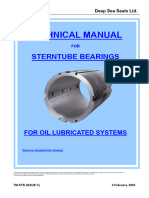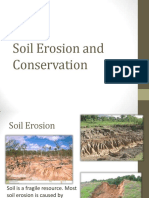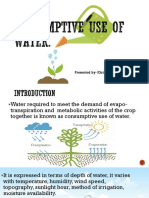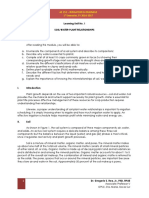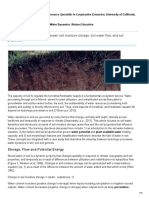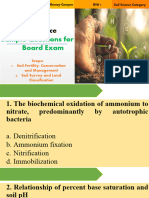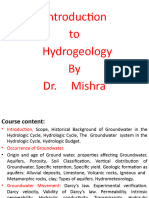Soil Physics: Solid Phase
Soil Physics: Solid Phase
Uploaded by
Andrae GenusCopyright:
Available Formats
Soil Physics: Solid Phase
Soil Physics: Solid Phase
Uploaded by
Andrae GenusOriginal Description:
Original Title
Copyright
Available Formats
Share this document
Did you find this document useful?
Is this content inappropriate?
Copyright:
Available Formats
Soil Physics: Solid Phase
Soil Physics: Solid Phase
Uploaded by
Andrae GenusCopyright:
Available Formats
SOIL PHYSICS
SOLID PHASE
The solid phase is the only permanent component of the soil.
The solid phase is made up of:
Mineral particles: have various shapes and sizes
Organic matter: has no definite shape (amorphous)
Particles size and mineral composition determine the nature
and behavior of the soil:
Surface area
Porosity
Interactions with fluids
Thermal regime
SOIL PHYSICS
SOLID PHASE: Particle Sizes, Shapes and Specific Surface
Soil particles can be classified according to
Size
Shape or geometry
Density
Mineral composition
Size
Based on size
50 m < sand < 2,000 m
2 m < silt < 50 m
clay < 2 m
SOIL PHYSICS
SOLID PHASE: Particle Sizes, Shapes and Specific Surface
Soil Texture: Defined as the relative proportions of sand, silt &
clay fractions.
SOIL PHYSICS
SOLID PHASE: Particle Sizes, Shapes and Specific Surface
Soil Texture carries both quantitative and qualitative terms:
Qualitatively: refers to the feel (e.g. coarse, gritty, smooth)
Quantitatively: refers to the measured distribution of particle
sizes and the proportions of the relative size ranges of particles
comprising a soil.
Soil texture is thus an intrinsic attribute of a soil and the most
often used to characterize a soil.
SOIL PHYSICS
SOLID PHASE: Particle Sizes, Shapes and Specific Surface
Textural fractions
Traditional method involved dividing the separates (sand, silt,
and clay) based on particle diameter.
The current procedure involves the use of a standard method
called mechanical analysis.
Unfortunately, there is still no universally accepted scheme of
classifying particle sizes.
The conventional definition of soil material is particles < 2 mm.
SOIL PHYSICS
SOLID PHASE: Particle Sizes, Shapes and Specific Surface
SOIL PHYSICS
SOLID PHASE: Particle Sizes, Shapes and Specific Surface
SOIL PHYSICS
SOLID PHASE: Particle Sizes, Shapes and Specific Surface
Soil Classes
Textural class is determined on the basis of the mass ratios of
three fractions: sand, silt, and clay.
Soils with different proportions are assigned to different
classes.
These classes are based on soil textural triangle.
We use mainly the USDA triangle which has 12 classes.
SOIL PHYSICS
SOLID PHASE: Particle Sizes, Shapes and Specific Surface
Soil Textural Triangle
SOIL PHYSICS
SOLID PHASE: Particle Sizes, Shapes and Specific Surface
Particle Size Distribution
Since soil is a continuous array of particle sizes, division into
discrete fractions is arbitrary.
Although textural triangle is widely followed and useful in
many ways, it is important to evaluate the complete array and
distribution of particle sizes.
This can be achieved use of particle size distribution curves.
These curves are a plot of the % of soil particles vs the
diameters smaller than a denoted diameter.
SOIL PHYSICS
SOLID PHASE: Particle Sizes, Shapes and Specific Surface
Particle Size Distribution
SOIL PHYSICS
SOLID PHASE: Particle Sizes, Shapes and Specific Surface
Mechanical Analysis
Mechanical analysis is the procedure to determine the particle
size distribution of soil samples.
Dispersion of soil aggregates. Soil is often aggregated and must
be separated into discrete particles.
The main cementing agents are organic matter, CaCO3 and
iron oxides.
Deflocculation is carried out by chemical dispersants and
mechanical methods.
SOIL PHYSICS
SOLID PHASE: Particle Sizes, Shapes and Specific Surface
Mechanical Analysis
Steps:
Dispersion of soil aggregates:
Oxidative dispersion : by use of hydrogen peroxide (H2O2)
Chemical dispersion: using calgon (Na hexametaphosphate)
Mechanical dispersion: by use of a mechanical stirrer
Settling in sedimentation cylinder based on Stokes law.
q
2
9
2
r g
t
L
v
F p
) (
= =
4 2
9
2
2
d
r
t g
L
F p
= =
) (
q
d
t
A
=
2 1/
SOIL PHYSICS
SOLID PHASE: Particle Sizes, Shapes and Specific Surface
Mechanical Analysis
Steps:
Measurement of particle distribution using:
pipette method
hydrometer method.
SOIL PHYSICS
SOLID PHASE: Particle Sizes, Shapes and Specific Surface
Mechanical Analysis
Question 7: Using Stokes law, calculate the time needed
for all sand particles to settle out of a depth of 0.2 m in an
aqueous suspension at 30C.
How long would it take for all silt particles to settle out?
SOIL PHYSICS
SOLID PHASE: Particle Sizes, Shapes and Specific Surface
Mechanical Analysis
Question 7: Using Stokes law, calculate the time needed
for all sand particles to settle out of a depth of 0.2 m in an
aqueous suspension. How long would it take for all silt
particles to settle out?
Given:
Radius of sand particles > 25 m
Dynamic viscosity = 1.110
-3
kg m
-1
s
-1
Density of water = 9.81
kg m
-3
Particle Density = 2650
kg m
-3
SOIL PHYSICS
SOLID PHASE: Particle Sizes, Shapes and Specific Surface
Mechanical Analysis
2
2
9
r g
L
t
F p
) (
q
=
s
m m kg s m .
m . s m kg .
t
sand
) ( ) (
97
10 25 981 2650 81 9 2
2 0 10 1 1 9
2 2 6 3
2
1
1
3
=
=
hr
m m kg s m .
m . s m kg .
t
silt
) ( ) (
17
10 1 981 2650 81 9 2
2 0 10 1 1 9
2 2 6 3
2
1
1
3
=
=
SOIL PHYSICS
SOLID PHASE: Particle Sizes, Shapes and Specific Surface
Shape
The property and behavior of the soil in bulk is affected by:
Particle size
Mineral composition
Particle shape
Regular shape
Irregular shape
Sand and silt particles are spherical or cubical shape.
Clay are platelet-like or lath-like shaped.
SOIL PHYSICS
SOLID PHASE: Particle Sizes, Shapes and Specific Surface
Specific Surface
The specific surface of a soil mineral is defined as the surface
area A
s
of particles per unit mass (a
m
) or per unit volume (a
v
) or
per unit bulk volume of soil (a
b
).
where M
s
is the mass of particles of volume V
s
contained in a
bulk volume V
t
of soil.
The units are traditionally expressed in m
2
g
-1
or m
2
cm
-3
Convert to SI units: m
2
g
-1
= 10
3
m
2
kg
-1
and m
2
cm
-3
= 10
6
m
2
m
-3
s s m
M A a / =
s s v
V A a / =
t s b
V A a / =
SOIL PHYSICS
SOLID PHASE: Particle Sizes, Shapes and Specific Surface
Specific Surface
Specific surface is related to:
Size
Shape
Many physical, chemical and biological reactions occur at
surfaces.
Determination of specific surface is based on:
Particle geometry
Adsorption characteristics
Heat of immersion
SOIL PHYSICS
SOLID PHASE: Particle Sizes, Shapes and Specific Surface
Particle Geometry
a) Cube with size, L
b) Sphere with diameter, d
c) Regular polyhedron with diameter, d
L L
L
S
s s
6 6
3
2
= =
2
6L area =
3
L mass
s
=
2
4 r area t =
s
r mass t
3
3
4
=
d r
r
S
s s
t
t 6 3
4
4
3
2
=
=
(s) nA ) area (S
k n
=
6
s k
(s)d nA
mass =
d
S
s
6
=
SOIL PHYSICS
SOLID PHASE: Particle Sizes, Shapes and Specific Surface
Particle Geometry
d) lath and rod shaped clay particles
a area surface 4 2
2
+ =
a
2
o a volume= s
a mass o
2
=
|
.
|
\
|
+ =
+
=
o o
o o 2 1 2 4 2
2
2
a a
a
S
s s
) (
a <<
o o
s s
S
4 2 2
=
~
a
1 1
>>
SOIL PHYSICS
SOLID PHASE: Particle Sizes, Shapes and Specific Surface
Particle Geometry
e) plate-like clay particles
) 2 b a (ab area surface + + =
b
a
o ab volume= s
ab mass o =
|
.
|
\
|
+ + =
+ +
=
a b ab
b a ab
S
s s
1 1 1 2 ) ( 2
o o
o o
b a , <<
o
s
S
2
~
SOIL PHYSICS
SOLID PHASE: Particle Sizes, Shapes and Specific Surface
Question 8: Estimate the approximate specific surface of a
soil composed of :
10% coarse sand: 1,000m (av. diameter)
20% fine sand: 100m (av. diameter)
30% silt: 20m (av. diameter)
20% kaolinite clay: 40 nm (av. platelet thickness)
10% illite clay: 5 nm (av. thickness)
10% montmorillonite: 1 nm (av. thickness).
You might also like
- DR Sebi - Electric Foods ListDocument3 pagesDR Sebi - Electric Foods ListTehuti byNature91% (64)
- AGR 351 - Soil Water Movement - PPT 1 - Agri JunctionDocument27 pagesAGR 351 - Soil Water Movement - PPT 1 - Agri JunctionKavinNo ratings yet
- TM STB C-Stern Tube BRGDocument28 pagesTM STB C-Stern Tube BRGKyaw Win Tun100% (1)
- Dr. Sebi Nutritional GuideDocument15 pagesDr. Sebi Nutritional GuideDonnaveo Sherman91% (54)
- Unit 303 WorkbookDocument11 pagesUnit 303 WorkbookCarla LemesNo ratings yet
- CH - 4 Soil Water Plant RshipDocument53 pagesCH - 4 Soil Water Plant RshipTeamireab DestaNo ratings yet
- Apes Soil LabDocument5 pagesApes Soil Labapi-236697820No ratings yet
- 12 Soil Erosion and ConservationDocument16 pages12 Soil Erosion and ConservationPyae Phyo Kyaw100% (3)
- Module 3 Physical Properties of SoilsDocument14 pagesModule 3 Physical Properties of Soilsali baltazarNo ratings yet
- Soil Physics: The Solid Phase: Nature and Behavior of ClayDocument23 pagesSoil Physics: The Solid Phase: Nature and Behavior of ClayAndrae GenusNo ratings yet
- Chapter 4 Model of ErosionDocument7 pagesChapter 4 Model of ErosionmekonnenNo ratings yet
- Consumptive Use of WaterDocument12 pagesConsumptive Use of WaterKhriezhatuo Vimerha100% (1)
- 14 Bench TerracesDocument3 pages14 Bench TerracesRubybharat100% (2)
- Chapter 3 Crop Water RequirementsDocument39 pagesChapter 3 Crop Water RequirementsAhmedNo ratings yet
- Chapter 9 - Integrated Watershed ManagementDocument27 pagesChapter 9 - Integrated Watershed ManagementSudharsananPRS100% (1)
- In-Situ Moisture Conservation Principle and PracticesDocument15 pagesIn-Situ Moisture Conservation Principle and Practicesmanikandan.v100% (3)
- Chapter 2 Soil-Water-PlantDocument50 pagesChapter 2 Soil-Water-PlantMūssā Mūhābā ZēĒthiopiāNo ratings yet
- Soil Water Plant Relationship-1Document55 pagesSoil Water Plant Relationship-1Ameer ali100% (1)
- Soil ConservationDocument12 pagesSoil ConservationNicole ParaisoNo ratings yet
- Lect 1 - Soil Water Plant RelationshipDocument10 pagesLect 1 - Soil Water Plant RelationshipAbe Jonard Manglal-lanNo ratings yet
- Name of The Instrument:: EvaporationDocument1 pageName of The Instrument:: EvaporationDavid Humphrey100% (1)
- Soil Moisture ConstantsDocument60 pagesSoil Moisture ConstantsPurushotham PaspuletiNo ratings yet
- INTRO TO Irrigation and DrainageDocument2 pagesINTRO TO Irrigation and DrainageJose Carlo Dizon100% (1)
- Cropping System Cropping SystemDocument8 pagesCropping System Cropping Systemyoutube premiumNo ratings yet
- Soil Structure, Density, and Porosity: Laboratory #4Document32 pagesSoil Structure, Density, and Porosity: Laboratory #4ZevanyaRolandTualakaNo ratings yet
- AGR 351 - Methods of Irrigation - PPT 1 - Agri JunctionDocument31 pagesAGR 351 - Methods of Irrigation - PPT 1 - Agri JunctionKavin100% (1)
- QuestionnaireDocument4 pagesQuestionnaireDiether DavidNo ratings yet
- Soil Water Dynamics, 2013Document15 pagesSoil Water Dynamics, 2013André FerrazNo ratings yet
- Lecture 1 and 2 - FUNDAMENTALS OF SOIL SCIENCEDocument40 pagesLecture 1 and 2 - FUNDAMENTALS OF SOIL SCIENCEAnshumaanNo ratings yet
- Crop SciDocument11 pagesCrop SciErla Adela MagallanesNo ratings yet
- Unit II 2nd PartDocument3 pagesUnit II 2nd PartSachin BhardwajNo ratings yet
- Physical Properties of SoilsDocument11 pagesPhysical Properties of SoilsTarpan ChakmaNo ratings yet
- Stwes Class GlasodDocument5 pagesStwes Class GlasodNadya Anggi HastitiNo ratings yet
- Soil Science Sample Ale Review Questions 081408Document53 pagesSoil Science Sample Ale Review Questions 081408Kay Ponilas100% (1)
- Chapter - Three & FourDocument35 pagesChapter - Three & FourKubaNo ratings yet
- Chapter 1-Introduction To Ecological PrinciplesDocument49 pagesChapter 1-Introduction To Ecological PrinciplesMuhammad DanialNo ratings yet
- SAC 101 Fundamentals of Soil ScienceDocument5 pagesSAC 101 Fundamentals of Soil Sciencerajap02100% (4)
- HPPT 1Document127 pagesHPPT 1manaseessau5No ratings yet
- Irrigation Principles and PracticesDocument40 pagesIrrigation Principles and PracticesRyan Paul Caalem100% (1)
- Water ResourcesDocument67 pagesWater ResourcesnischalbastolaNo ratings yet
- Soil Physical Properties - 03!02!2023Document68 pagesSoil Physical Properties - 03!02!2023Gabby ChebetNo ratings yet
- EXERCISE 10 Organic Matter DecompositionDocument3 pagesEXERCISE 10 Organic Matter DecompositionKobe Conrad AbelleraNo ratings yet
- Preparation of Structure Contour MapDocument6 pagesPreparation of Structure Contour MapAn Open Letter100% (2)
- Soil Plant Water RelationshipsDocument27 pagesSoil Plant Water Relationshipskharladrian100% (1)
- 2.1. Soil Fertility and ProductivityDocument8 pages2.1. Soil Fertility and Productivityalemneh bayehNo ratings yet
- Method of IrrigationDocument6 pagesMethod of IrrigationKazi Shihab ShahriarNo ratings yet
- 13 Contour and Graded BundDocument3 pages13 Contour and Graded BundRubybharatNo ratings yet
- Soil ScienceDocument5 pagesSoil ScienceMohamed El BaghdadiNo ratings yet
- Soil Erosion and Conservation 1Document66 pagesSoil Erosion and Conservation 1Cyrone Partusa100% (1)
- SOL507Document2 pagesSOL507Mahendra paudel PaudelNo ratings yet
- I. Soil-Water-Plant RelationshipDocument50 pagesI. Soil-Water-Plant RelationshipJose Carlo Dizon0% (1)
- Problems and Prospects of Rainfed Agriculture in IndiaDocument20 pagesProblems and Prospects of Rainfed Agriculture in IndiaTaushif Ahammed0% (1)
- Mcqs SacDocument87 pagesMcqs SacMadhumitha100% (1)
- GP 18 Watershed ManagementDocument21 pagesGP 18 Watershed ManagementHabtamu YalewNo ratings yet
- L3 - Atterbergs Limit, Soil ConsistencyDocument36 pagesL3 - Atterbergs Limit, Soil ConsistencySeaWhat SeasNo ratings yet
- Bench Terrace-Mojo2015Document71 pagesBench Terrace-Mojo2015MelikteNo ratings yet
- Floculation and DispersionDocument20 pagesFloculation and DispersionVipby MirawatieNo ratings yet
- Plant Growth and DevelpomentDocument23 pagesPlant Growth and DevelpomentvertebratesNo ratings yet
- Soil Conservation and WastelandDocument47 pagesSoil Conservation and WastelandLakshman RNo ratings yet
- Lecture No. 2 Soil Organic MatterDocument44 pagesLecture No. 2 Soil Organic MatterMark Robert CatolosNo ratings yet
- Soil and Water Conservation: Department of Agriculture EngineeringDocument14 pagesSoil and Water Conservation: Department of Agriculture Engineeringragavi mohanadas100% (1)
- Lecture 3-Hydrological Data For Watershed PlanningDocument20 pagesLecture 3-Hydrological Data For Watershed PlanningChu DicksonNo ratings yet
- Soil Physical Properties - Those PropertiesDocument29 pagesSoil Physical Properties - Those PropertiesMarigel AgsunodNo ratings yet
- Blank Student Concept MapDocument2 pagesBlank Student Concept MapAndrae GenusNo ratings yet
- F in 016 Chloride TitrationDocument2 pagesF in 016 Chloride TitrationAndrae GenusNo ratings yet
- Carbon Decomposition in An Organic Farming SystemDocument30 pagesCarbon Decomposition in An Organic Farming SystemAndrae GenusNo ratings yet
- Spirituality Book ListDocument4 pagesSpirituality Book ListAndrae GenusNo ratings yet
- BOOK LIST To Improved Information Ability February 26Document5 pagesBOOK LIST To Improved Information Ability February 26Andrae Genus100% (3)
- 8 Groundwater and Surface Water NotesDocument2 pages8 Groundwater and Surface Water NotesAndrae GenusNo ratings yet
- Prot Is T Graphic OrganizerDocument1 pageProt Is T Graphic OrganizerAndrae GenusNo ratings yet
- Infectious DiseasesDocument15 pagesInfectious DiseasesAndrae GenusNo ratings yet
- Study Guide For Cells TestDocument1 pageStudy Guide For Cells TestAndrae GenusNo ratings yet
- Partner 1: - Partner 2: - PeriodDocument2 pagesPartner 1: - Partner 2: - PeriodAndrae GenusNo ratings yet
- Unit 2 Test - CellsDocument4 pagesUnit 2 Test - CellsAndrae GenusNo ratings yet
- Around The World Microscope LabDocument2 pagesAround The World Microscope LabAndrae GenusNo ratings yet
- cm117 2Document162 pagescm117 2B'Thaveephone DsngNo ratings yet
- (1976) The Ideology of The TextDocument44 pages(1976) The Ideology of The TextElmore HawkshawNo ratings yet
- Dispensing Per TGL 22 Januari 2022 (H1)Document6 pagesDispensing Per TGL 22 Januari 2022 (H1)Jajat Rahayu EkaNo ratings yet
- OSHA 10-Hour General Industry Final Exam Answer KeyDocument11 pagesOSHA 10-Hour General Industry Final Exam Answer KeyScribdTranslationsNo ratings yet
- Defecte MultiplexareDocument22 pagesDefecte MultiplexareGoranka Bulatovic IlicNo ratings yet
- CGA 07dec2016 BallatoreDocument59 pagesCGA 07dec2016 BallatoreKumar AnupamNo ratings yet
- FinalDetailed Advt 02 2024Document16 pagesFinalDetailed Advt 02 2024khelvaartalap1599No ratings yet
- ThePowerPart1 - Jeff GignacDocument26 pagesThePowerPart1 - Jeff GignacTomV77No ratings yet
- Geomorphic HazardsDocument22 pagesGeomorphic HazardsSANJAY KUMAR YADAV MtechNo ratings yet
- Framis Manuale 6 ENGDocument112 pagesFramis Manuale 6 ENGLeydi Nathaly Sanchez BastidasNo ratings yet
- E&G - Quaternary Science Journal: Glaciations and Periglacial Features in Central EuropeDocument188 pagesE&G - Quaternary Science Journal: Glaciations and Periglacial Features in Central EuropeGeozon Science MediaNo ratings yet
- BBD'22 Cheat Sheet ElectronicsDocument34 pagesBBD'22 Cheat Sheet ElectronicsAbel Soby JosephNo ratings yet
- SOAL ENGLISH SIMAK 2011 Kode 201Document20 pagesSOAL ENGLISH SIMAK 2011 Kode 201soerdepoerNo ratings yet
- Experiment Shearing ForcesDocument17 pagesExperiment Shearing ForcesAnushaBheenuck73% (11)
- Villar, Valeriano Jr. D. - EconDocument13 pagesVillar, Valeriano Jr. D. - Econjung biNo ratings yet
- Automotive Steering Alignment ASE-A4 Suspension and SteeringDocument81 pagesAutomotive Steering Alignment ASE-A4 Suspension and Steering2791957100% (2)
- Soal Mid-Semester Bing 2021Document4 pagesSoal Mid-Semester Bing 2021rizky andika suwardiNo ratings yet
- Optional Lecture 3: Wall Boiling Models: 16.0 ReleaseDocument56 pagesOptional Lecture 3: Wall Boiling Models: 16.0 ReleasemNo ratings yet
- MS - 4 Manhole Installation Rev.0 BausherDocument18 pagesMS - 4 Manhole Installation Rev.0 BausherSyed Umair HashmiNo ratings yet
- 图纸 ASRock A55M-VS r100Document35 pages图纸 ASRock A55M-VS r100okeinfo100% (2)
- Abstract - For The Blood of Gaia, FilipponeDocument3 pagesAbstract - For The Blood of Gaia, FilipponeChristine FilipponeNo ratings yet
- Worksheets: Correlation and PatternsDocument15 pagesWorksheets: Correlation and PatternsDanny CherishNo ratings yet
- Smart Plug Installation GuideDocument9 pagesSmart Plug Installation GuideFrancisco GuerreroNo ratings yet
- Men's Health UK - March 2019 PDFDocument132 pagesMen's Health UK - March 2019 PDFDIPOLMEDIANo ratings yet
- Holding On To You: Twenty Øne PiløtsDocument3 pagesHolding On To You: Twenty Øne PiløtsKen KanekiNo ratings yet
- Mod01 L02Document12 pagesMod01 L02Pankaj Kumar SainiNo ratings yet
- Si Man ChapDocument17 pagesSi Man ChapThettinAungNo ratings yet
- Technicolor Tg789vacv2Document5 pagesTechnicolor Tg789vacv2tester1972No ratings yet


